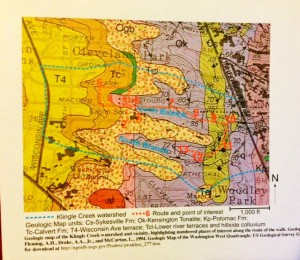 POINTS OF INTEREST DURING GEOLOGICAL TOUR OF TREGARON
POINTS OF INTEREST DURING GEOLOGICAL TOUR OF TREGARON
Back by popular demand, Tony Fleming, a renowned professional geologist and hydrologist who grew up one block from Tregaron Estate and is the author of the modern geological map of the District, will lead a fascinating tour of Tregaron’s natural history. We will meet at the top of the north meadow (aka “sledding hill”) at 1 p.m. for a hot beverage while Tony gives an overview. Enter either of Tregaron’s entrances at 3100 Macomb Street or 3029 Klingle Road; walk up the driveway to the top of the hill.
Below are excerpts from Tony’s program: “Tregaron is an incredible neighborhood resource. With its deep ravines, old woods, and elegant landscape architecture, Tregaron is singularly responsible for much of the environmental ambiance that defines this section of Cleveland and Woodley Parks. Tregaron is a veritable showcase of geologic and ecologic features and processes that include outcrops of some of Washington’s oldest rocks, unusually large crystals, an ancient channel of the Potomac River, architectural use of native building stone, a biologically diverse landscape, and many environmental issues related to the interface of water and infrastructure in the urban environment.
A description of the tour: This leisurely loop hike will showcase a wide variety of natural features, landscape architecture, and environmental issues, with time for questions and discussion. Did you know that the local bedrock was not originally part of North America? That giant crystals of hornblende and staurolite occur on the property? Can you tell the difference between native plants and invasive non-native ones? Why is Klingle Road so flood-prone? Do we need to worry about earthquakes? Why did the earthquake of 2011 result in so much damage? The tour will highlight all of these topics and more!”
Stops below will be covered during the afternoon walk at Tregaron. The assigned numbers for each stop co-relate to the geological map provided.
9. The streambed in Tregaron is relatively natural, despite relatively minor alterations left over from the original estate landscaping, such as the stone bridges. One reason this section remains relatively intact is its steepness: the streambed is carved into solid rock the entire distance, which makes it relatively stable and much less susceptible to erosion and sedimentation, and much more difficult to modify for development. The main bedrock units exposed in Tregaron are the Sykesville Formation, a metamorphic rock that accumulated in a deep submarine trench adjacent to the Taconic island arc, and the Kensington Tonalite, an intrusive rock that crystallized deep in the roots of the volcanic arc. The latter was formerly known as “Rock Creek Granite” and was quarried for building stone at the nearby Newark Street Quarry, where the main Cleveland Park commercial district now sits on the west side of Connecticut Avenue. Numerous structures in the neighborhood are faced with this attractive stone.
The deep, cool valley has a strong influence on vegetation, supporting a variety of more moisture- loving trees and plants not naturally found on the adjacent uplands.
10. Confluence. The North Branch joins the South Branch along Klingle Road directly opposite the northeast corner of Tregaron. In this lowest part of the estate, the stream gradient abruptly slackens, and the narrow bottom of the ravine is filled with sand and silt on the upstream side of Klingle Road. As with the rest of the drainage infrastructure associated with Klingle Road, the culvert that carries the North Branch beneath the road is woefully undersized and not regularly maintained, hence it has become filled with debris over time. As a result, the road acts like a dike during periods of high streamflow, causing sediment to fall out at this spot. This process is even more striking a few hundred feet up Klingle Road, where the South Branch emerges from Tregaron (stop 11). There, the entire bottomland is filled with silt and sand for at least 100 feet upstream of the road.
11. Klingle Road (multiple stops) itself lies in the narrow, deeply entrenched ravine of the south branch of Klingle Valley. Solid bedrock floors the valley and extends up the valley walls for tens of feet. The road follows (apparently with little forethought) and is named after a historical 18th century wagon trail that led from Georgetown to the Klingle Estate (aka Linnean Hill), now the administrative headquarters of Rock Creek Park. The road has been closed for some 20 years and exemplifies the folly of trying to maintain a busy commuter thoroughfare along what is essentially an active, unstable, and flood-prone, V-shaped Piedmont valley. At many places, the road has been severely damaged by floods, which recur regularly due to urban runoff from the surrounding uplands. The District has had plans on the board for decades to completely reconstruct the road—the engineering works required to mitigate flooding and stabilize the road would be enormously costly and would involve severe ecological and hydrological disruption to both the valley and to Tregaron—but resistance from the park service and others has thus far held such a project. Even with such an effort, it is questionable whether the road could ever be viable in the long term, given the geological processes at work in the valley. Many rock outcrops and cascades in this section of the valley illustrate the ‘fall zone’, the fundamental physiographic feature on which the Nation’s capital was (of necessity) established, and attest to the active downcutting of the valley that is occurring now.
12. The Causeway leading into Tregaron from Klingle Road exemplifies both the use of local building stone and the architectural style of the Tregaron Estate. The causeway is a freestanding stone arch built out of Potomac Bluestone, the most widely utilized of several local building stones. Hundreds of structures in and around the District contain Potomac Bluestone, either as facing, foundation stone, or as decorative trim. The classic bluestone quarries were located along the Potomac Palisades adjacent to GW Memorial Parkway in Arlington County and operated from the 1700’s until 1938.
13. The Tregaron Lily Pond occupies the valley of the South Branch. The pond was restored a few years ago after decades of neglect, when it had all but filled in with flood debris and leaves. At this stop we will look for evidence of the hydrologic and hillside processes that have shaped this valley for millennia and continue to do so.
Please rsvp for the Geology Tour of Tregaron, November 15th at 1 p.m.
We’ll meet at the top of the meadow (aka “sledding hill”) at 1pm.

